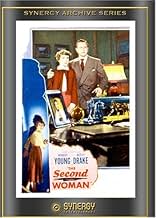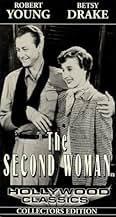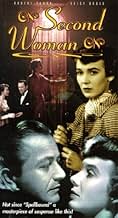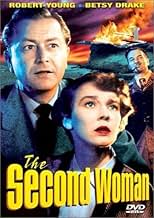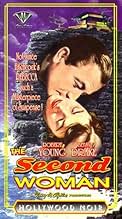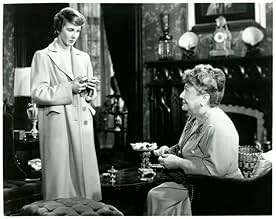Füge eine Handlung in deiner Sprache hinzuIn flashback from a 'Rebecca'-style beginning: Ellen Foster, visiting her aunt on the California coast, meets neighbor Jeff Cohalan and his ultramodern clifftop house.In flashback from a 'Rebecca'-style beginning: Ellen Foster, visiting her aunt on the California coast, meets neighbor Jeff Cohalan and his ultramodern clifftop house.In flashback from a 'Rebecca'-style beginning: Ellen Foster, visiting her aunt on the California coast, meets neighbor Jeff Cohalan and his ultramodern clifftop house.
- Stacy Rogers
- (as Jason Robards)
- Mr. Nelson
- (as Jimmy Dodd)
- Porter
- (Gelöschte Szenen)
- Country Club Guest
- (Nicht genannt)
- Giovanni Strobini
- (Nicht genannt)
- Country Club Guest
- (Nicht genannt)
Empfohlene Bewertungen
Young plays an architect brooding over the death of his fiancé in an auto crash in which he was the driver the previous year. After a series of apparent accidents, including a suspicious injury to his horse and a fire at his house, it appears that either someone is out to get him, or he is actually doing destructive things to himself because he is a dangerously off-his-nut paranoiac. The local doctor (Morris Carnovsky) believes the latter. His newly acquired girl friend (Drake), who works in statistical studies for an insurance company, turns detective to prove it is the former. The mystery unfolds at a leisurely pace at first but gradually builds tension with surprising twists and turns of the plot. As with any good thriller, you begin to suspect everyone. A brooding, almost Gothic mood is maintained by Joseph Nussbaum's haunting Tchaikovsky-based score and Hal Mohr's alternately dark and luminous black and white cinematography. Frequent shots of the surf crashing on the lonely rocks of the Central California shore help set the forlorn ambiance. Kern's direction is precise, dialog is intelligent, editing smooth. Young and Drake are charming, and they get expert support from Carnovsky, Henry O'Neil, Florence Bates, and John Sutton.
The Second Woman successfully blends elements of mystery, noir, Gothic, and romantic melodrama. Though released in July 1950, its sensuous style and feel seem to belong more to the l940's than to the 'fifties. But when decades are accounted properly, the year 1950 is actually the last year of the decade we nickname "the forties". In any case it was made near the end of an era. Due to collapse of the studio systems, death and retirement of key personnel, adverse changes in public taste, and other factors, by the end of the 1950's they would no longer be able to make pictures as classy and entertaining as The Second Woman.
Top entertainment from Hollywood's Golden Era.
Robert Young plays a young architect who can't wriggle out from under a jinx. The night before their wedding, a car crash claimed the life of his fiancée, for whom he'd built the cantilevered "house with wings." Now it's a mausoleum where he broods to the Tchaikovsky on the sound track. Lapses of memory and moody episodes undermine his work. His horse, his dog, even his prize rosebush die mysteriously. He's sinking, an object of pity and, increasingly, apprehension.
Into this slough of despond comes a guardian angel (Betsy Drake), an intelligent and independent insurance investigator who falls for him, as he for her. (She's something of an anomaly in film noir, where all the brains and spunk usually go to the wicked women.) She supplies Young with the resolve to solve the puzzle when he ceases to care.
There are weak points as well. The suicide attempt that opens the movie makes scant sense when it's later explained; the character set up as a villain emerges, at least partly, as a red herring; and the formidable Florence Bates disappears into a bland "also-starring" role. And constantly referring to past events in a low-key, almost abstract way lays poor preparation for the ending, where they prove central. Still, The Second Woman keeps you puzzled, and the Gothic trappings work their spell. Less film noir than mystery, it's nonetheless a good, old-fashioned one.
A chicly attired Betsy Drake - ironically Mrs Cary Grant at the time - provides an attractive and robust female lead.
Architect Jeff Cohalan (Young) is a troubled man, after the mysterious death of his fiancée in a car crash, he has been acting strangely and lives a lonely life at the Hilltop House he designed for his bride to be. When he meets Ellen Foster (Drake), things perk up as he becomes attracted to her. But he is constantly plagued by bad luck, something which doesn't go unnoticed by Ellen, who suspects that Jeff may not be the victim of paranoia, but of something sinister perpetrated by outside forces
The Coast of Kings.
If you can get away from the looming presence of such great films like Gaslight and Rebecca, then James Kern's movie holds some Gothic noir rewards. The house at the centre of tale is a modern development, which is a shame as it goes against the coastal atmosphere lifting up from the Carmel-On-Sea location that was used for these parts of the film, but otherwise there's a strong brooding mystery bubbling away throughout. As the bizarre instances of misfortune start to mount up on Jeff Cohalan, with director Kern showing a good appreciation of pacing, it builds up a menacing head of steam and then unravels a better than adequate denouement.
Vivian, Vivian, Vivian
Young and Drake inevitably tug at a romantic thread, but they make for an engaging couple and Drake especially gets her teeth into a female role of intelligent substance. John Sutton files in for some decent caddish quotient and Bates and O'Neil add some professionally elder support. Mohr's (Bullets or Ballets/The Lineup) photography is the key, consistently at one with the psychological beats of the plotting, his lighting compositions make the film seem far more higher in production value than it was.
A tale of memory lapses, pet bothering, depression, ugly real estate, dastards and romance, is nicely cloaked by ominous coastal atmospherics and Tchaikovsky! 7/10
Wusstest du schon
- WissenswertesAt the beginning of the movie, Robert Young's character tries to commit suicide by running his car engine in an enclosed garage. Then in flashback, the doctor says that he's concerned about Young's character's recurring bouts of depression. In real life, Young suffered from depression for decades, and tried to commit suicide in Westlake Village, CA in January 1991 by running a hose from his exhaust pipe into the interior of his car. Young called a tow truck to try to start his car. The driver noticed the hose, and contacted the police.
- PatzerIn the opening scene, Robert Young's character is discovered suffocated by heavy carbon monoxide in a sealed garage, but nobody else coming in the garage is affected by the deadly gas. Additionally, unless a car is burning oil or running very rich, exhaust fumes are not visible as was shown here. This reveals some type of smoke or vapor was used, not an actual auto exhaust.
- Zitate
Jeff Cohalan: Let's see what the tea leaves say about you... there's a trick my grandmother taught me; she learned it from an old witch in Ireland.
Ellen Foster: And so you've been drinking coffee ever since.
- VerbindungenReferenced in This Movie Must Die!: The Second Woman (1950) (2021)
Top-Auswahl
- How long is The Second Woman?Powered by Alexa
Details
- Laufzeit
- 1 Std. 31 Min.(91 min)
- Farbe
- Seitenverhältnis
- 1.33 : 1

